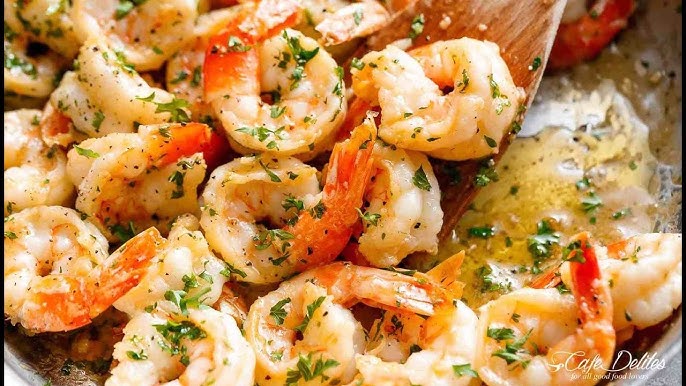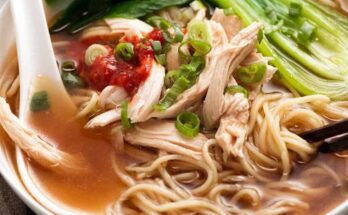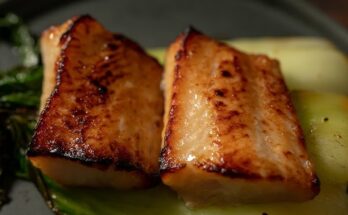Best Shrimp Scampi Recipe: Shrimp Scampi is one of those dishes that sounds fancy but is incredibly easy to make. It’s a classic Italian-American recipe that brings together juicy shrimp, aromatic garlic, rich butter, a splash of white wine, and a squeeze of lemon juice. Served over pasta, rice, or even zucchini noodles, this dish is both comforting and elegant. Originating from the Italian word “scampo,” which refers to a type of small lobster, the American version has evolved using shrimp instead, making it more accessible while still bursting with flavor.
Imagine twirling tender pasta noodles coated in a silky, garlic-butter sauce with plump shrimp nestled on top. Every bite is rich yet refreshing, hearty yet light. Whether you’re making dinner for a weeknight or entertaining guests, shrimp scampi hits all the right notes. Plus, it’s ready in under 30 minutes, making it one of the quickest gourmet-style dishes you can whip up at home.
Why This Recipe is a Crowd Favorite
This shrimp scampi recipe wins hearts because it combines simplicity with sophistication. The key is in its balanced flavors—the sharp zing of lemon juice cuts through the richness of butter and oil, while garlic adds a warm, inviting aroma that no one can resist. The wine gives it depth, and the shrimp themselves are meaty and satisfying.
What really makes this recipe a star, though, is its versatility. You can make it as spicy, creamy, or lemony as you like. Want to keep it keto? Skip the pasta and serve it with cauliflower rice. Feeling indulgent? Load it onto a bed of buttery linguine. It’s a flexible, foolproof dish that works for virtually every occasion and dietary preference.
Ingredients You’ll Need
Core Ingredients
To get started on the perfect shrimp scampi, gather these essentials:
- Shrimp (1 lb, peeled and deveined) – Choose medium to large shrimp for the best bite.
- Garlic (4-6 cloves, minced) – Fresh garlic infuses the dish with unbeatable flavor.
- Butter (4 tablespoons) – Unsalted is preferred to control the saltiness.
- Olive Oil (2 tablespoons) – Adds richness and helps sauté the garlic.
- White Wine (½ cup) – Choose a dry white wine like Sauvignon Blanc or Pinot Grigio.
- Lemon Juice (from 1 lemon) – Brightens and balances the buttery sauce.
- Red Pepper Flakes (½ teaspoon, optional) – Adds a bit of heat.
- Salt and Black Pepper (to taste) – Essential for seasoning.
- Fresh Parsley (2 tablespoons, chopped) – For garnish and freshness.
- Pasta (optional, like linguine or angel hair) – The classic base for serving.
Each of these ingredients plays a specific role. The butter and olive oil form the base of the sauce, while the wine deglazes the pan and adds a refined note. Lemon and garlic wake everything up, and the shrimp soak up all those flavors beautifully.
Optional Add-Ons for Extra Flavor
Want to level up your shrimp scampi game? Try incorporating these extras:
- Grated Parmesan Cheese – For a rich, cheesy finish.
- Cherry Tomatoes – Add sweetness and color.
- Spinach or Kale – Sneak in some greens.
- Mushrooms – For an earthy twist.
- Capers or Olives – To introduce a salty, briny flavor.
These add-ons allow you to tailor the dish to your taste or to the ingredients you already have at home. Don’t be afraid to experiment—shrimp scampi is very forgiving!
Step-by-Step Cooking Instructions
Step 1 – Prepping the Shrimp
Start by thawing your shrimp if they’re frozen. Run them under cold water for a few minutes until soft. Peel and devein them if they aren’t already. Pat them dry with a paper towel—this step is crucial. Wet shrimp won’t sear properly, and you want that light golden crust when they hit the hot pan.
At this stage, season your shrimp with a little salt and pepper. If you’re feeling bold, toss in a pinch of smoked paprika or cayenne for an extra kick. The seasoning will help enhance the shrimp’s natural flavor and get them ready for the buttery, garlicky bath they’re about to take.
Step 2 – Sautéing Garlic and Shrimp
Heat your olive oil and half the butter in a large skillet over medium heat. Once the butter melts and starts to bubble, toss in the minced garlic. Stir constantly to avoid burning—it should turn golden and fragrant within 30 seconds.
Now, add your shrimp in a single layer. Sear each side for 1-2 minutes until they turn pink and slightly opaque. Don’t overcrowd the pan; cook in batches if necessary. Once cooked, remove the shrimp and set aside, leaving the garlicky oil in the pan.
Step 3 – Deglazing with Wine
After removing the shrimp, you’ll notice those little browned bits stuck to the bottom of the pan—don’t toss them! That’s pure flavor gold. Pour in your white wine to deglaze the pan, using a wooden spoon to scrape up those flavorful bits. This step not only lifts those caramelized pieces but also builds a deeper, more complex sauce base.
Let the wine simmer for 2-3 minutes. You want the alcohol to cook off, reducing the wine slightly to concentrate the flavor. This is when your kitchen starts smelling like a five-star restaurant. If you’re not using wine, you can substitute it with chicken broth or seafood stock—it won’t taste exactly the same, but it’ll still be delicious.
This is the moment your scampi sauce starts coming to life. It’s light, fragrant, and ready to be enriched with lemon and butter for that classic creamy-yet-tangy profile.
Step 4 – Adding Lemon and Butter
Once the wine has reduced, it’s time to stir in the remaining butter. Do this gradually, one tablespoon at a time, whisking or stirring constantly to emulsify the butter into the sauce. This gives the scampi its signature silky texture without separating.
Now squeeze in the fresh lemon juice and add red pepper flakes if you’re craving a little heat. Stir everything together and let the sauce simmer gently for another minute or so. Taste and adjust with a pinch of salt or pepper if needed.
At this point, you should have a balanced, buttery, and citrusy sauce that’s full of garlicky goodness. If the sauce seems too thick, add a splash of pasta water to loosen it up—it’s starchy and perfect for clinging to your noodles.
Step 5 – Finishing with Fresh Herbs
With your sauce perfectly balanced, return the cooked shrimp to the skillet. Toss them gently to coat with the sauce and reheat for a minute or two. You don’t want to overcook them—they’re already done, so just warm them through.
Finish the dish by sprinkling freshly chopped parsley over the top. This simple addition adds a pop of color and a fresh, herbaceous note that ties everything together.
If you’re serving over pasta, toss the cooked pasta directly into the skillet and mix to combine. Let it all marry together for a minute before plating. A final squeeze of lemon over the top just before serving will take it from great to unforgettable.
Best Pasta Pairings for Shrimp Scampi
Traditional Pairings
When it comes to serving shrimp scampi, pasta is the classic go-to—and for good reason. Pasta provides the perfect vehicle for soaking up that luscious garlic-butter sauce. Here are the most popular pasta pairings:
- Linguine: The most traditional option, with just the right thickness to carry the sauce and support the shrimp.
- Angel Hair (Capellini): Light and delicate, ideal if you prefer a more subtle mouthfeel.
- Spaghetti: A versatile choice that works well with the scampi sauce.
- Fettuccine: Slightly thicker and richer, making it great for those who like a more indulgent dish.
No matter your pasta of choice, make sure it’s cooked al dente and don’t forget to reserve some pasta water. It’s liquid gold for thinning out your sauce while keeping all the flavor intact.
Low-Carb or Gluten-Free Options
Not into carbs or gluten? No problem—shrimp scampi is just as delicious with alternative bases. Here are some low-carb or gluten-free ideas that work beautifully:
- Zucchini Noodles (Zoodles): Light, fresh, and quick to cook.
- Spaghetti Squash: Nutty, slightly sweet, and makes a hearty base.
- Cauliflower Rice: Keeps the carbs low and lets the scampi shine.
- Gluten-Free Pasta: Available in rice, corn, or quinoa varieties—just watch the cook time.
The beauty of shrimp scampi is its adaptability. Whether you’re watching carbs or avoiding gluten, you can still enjoy every garlicky, buttery bite.
Tips and Tricks for Perfect Shrimp Scampi
Avoid Overcooking Shrimp
Shrimp are the stars of this dish, so handling them right is crucial. One of the most common mistakes in cooking shrimp scampi is overcooking the shrimp until they become rubbery and dry. Here’s how to avoid that culinary tragedy:
- Watch the color: Raw shrimp are gray and translucent. When they’re fully cooked, they turn pink and opaque with a slight curl.
- Cooking time: Most shrimp only need about 1-2 minutes per side in a hot skillet. As soon as they curl into a “C” shape and lose their transparency, they’re done.
- Residual heat: Remember, shrimp continue cooking even after you take them off the heat. That’s why many chefs recommend slightly undercooking them in the pan, then letting them finish cooking as they sit in the hot sauce.
Taking care with shrimp makes all the difference. When cooked properly, they’re juicy, tender, and packed with flavor—exactly what you want for your scampi.
Choosing the Right Wine
Wine might seem like a minor detail, but it plays a big role in balancing the richness of the dish. A good wine deglazes the pan, lifting all the caramelized bits and infusing the sauce with a light acidity that cuts through the butter and oil.
Here are some solid options:
- Sauvignon Blanc: Crisp and citrusy, perfect for lifting the sauce.
- Pinot Grigio: Light and slightly fruity, ideal for enhancing the shrimp.
- Chardonnay (unoaked): Buttery and smooth, matches the richness of the dish.
Avoid using sweet wines or anything oaky and overpowering. If you’re cooking without wine, you can substitute chicken broth, seafood stock, or even a splash of lemon juice mixed with water. The flavor won’t be exactly the same, but you’ll still end up with a delicious dish.
Also, don’t feel like you need an expensive bottle. A decent $10 wine will do just fine for cooking—and maybe even for sipping while you cook!
FAQs about Best Shrimp Scampi Recipe
1. What is shrimp scampi made of?
Shrimp scampi is typically made with large shrimp sautéed in butter, garlic, lemon juice, white wine (optional), and sometimes red pepper flakes, then tossed with pasta like linguine or spaghetti.
2. Can I make shrimp scampi without wine?
Yes! You can substitute white wine with chicken broth or a bit of lemon juice and water. It still tastes delicious and keeps the dish family-friendly.
3. How do I thicken the scampi sauce?
If you’d like a thicker sauce, you can add a touch of pasta water or a small amount of cornstarch slurry. But scampi sauce is usually meant to be light and silky.
4. What kind of shrimp should I use?
Use large or jumbo raw shrimp, preferably peeled and deveined. Frozen shrimp works great too—just thaw it completely before cooking.
5. Is shrimp scampi spicy?
Not by default, but you can add red pepper flakes for a little kick. Adjust the spice level to your taste.
6. Can I use pre-cooked shrimp?
You can, but be careful not to overcook it. Since it’s already cooked, just warm it briefly in the sauce to avoid rubbery shrimp.
7. What pasta pairs best with shrimp scampi?
Linguine, spaghetti, and angel hair pasta are traditional favorites. You can also use zucchini noodles for a low-carb version.
8. How long does it take to cook shrimp scampi?
It takes about 15–20 minutes total, making it a perfect quick and easy weeknight dinner.
9. Can I meal prep shrimp scampi?
It’s best served fresh, but you can prep the ingredients in advance. Cooked leftovers can be stored in the fridge for up to 2 days and reheated gently.
10. What sides go well with shrimp scampi?
Garlic bread, a fresh green salad, or roasted veggies are all excellent sides to round out your shrimp scampi meal.
Conclusion
From selecting the right shrimp and wine to mastering the garlic-lemon-butter sauce, every step is part of a beautifully orchestrated process that results in a plate of pure joy. And the best part? It’s customizable. Make it spicy, make it creamy, add veggies, or keep it classic—whatever suits your taste.
So next time you’re in the mood for something special but don’t want to spend hours in the kitchen, remember this shrimp scampi recipe. It’s your ticket to gourmet dining made easy.



